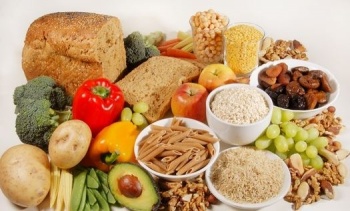Resistant Starch
Resistant starch is a type of starch that isn’t fully broken down and absorbed, but rather turned into short-chain fatty acids by intestinal bacteria. It passes through the small intestine into the large intestine undigested. Eventually, the beneficial microbes in the large intestine break down the starch into butyrate, which is fuel for healthy human cells.
Contents
Special Precautions of Resistant Starch
Internal fermentation of resistant starch can cause gas when high quantities are consumed. One review estimated that the acceptable daily intake of resistant starch may be as high as 45 grams in adults, an amount exceeding the total recommended intake for dietary fiber of 25-38 grams per day.
Health Benefits and uses of Resistant Starch are
Resistant Starch still plays an important role in our diets even though we don’t necessarily absorb it. When Resistant Starch is fermented in the large intestine, short chain fatty acids (SCFA) such as acetate, butyrate, and propionate, along with gases are produced. SCFAs can be absorbed into the body from the colon or stay put and be used by colonic bacteria for energy. Evidence suggests that SCFAs may benefit us in many ways :
- stimulate blood flow to the colon
- increase nutrient circulation
- inhibit the growth of pathogenic bacteria
- help us absorb minerals
- help prevent us from absorbing toxic/carcinogenic compounds
- Improved blood fats : RS may help to lower blood cholesterol and fats, while also decreasing the production of new fat cells (the latter has only been shown in rats). Also, since SCFAs can inhibit the breakdown of carbohydrates in the liver, RS can increase the amount of fat we utilize for energy.
- Better satiety : RS can help us feel full. SCFAs can trigger the release of hormones that reduce the drive to eat (leptin, peptide YY, glucagon like peptide). After someone starts eating more RS, it may take up to one year for gut hormones to adapt. RS slows the amount of nutrients released into the bloodstream, which keeps appetite stable.
- Better insulin sensitivity : RS doesn’t digest into blood sugar, which means our bodies don’t release much insulin in response. RS might also improve insulin sensitivity via alterations in fatty acid flux between muscle and fat cells. Some data indicate that ghrelin might increase with RS consumption, improving insulin sensitivity (this is counterintuitive since ghrelin drives appetite). RS may also lower blood fats (see above), which also improves insulin sensitivity.
- Improved digestion : RS may help alleviate irritable bowel syndrome, diverticulitis, constipation, and ulcerative colitis. RS can add bulk and water to the stool, aiding in regular bowel movements. SCFAs can help to prevent the development of abnormal bacterial cells in the colon and enhance mineral absorption (especially calcium).
- Better body composition : Since RS has less energy (calories) per gram than other starches, it can help us eat less. And consuming more RS may have a thermic effect in the body.
- Keeping us hydrated : For those receiving treatment for cholera and/or diarrhea, RS can assist in the rehydration process (since it can normalize bowel function).
- Improved immunity : Consuming RS can influence the production of immune cells and inflammatory compounds in the gut.
Categorization
Resistant starch (RS) is any starch or starch digestion products that are not digested and absorbed in the stomach or small intestine and pass on to the large intestine. RS has been categorized into four types:
- RS1 Physically inaccessible or undigestible resistant starch, such as that found in seeds or legumes and unprocessed whole grains.
- RS2 Resistant starch is inaccessible to enzymes due to starch conformation, as in high amylose corn starch
- RS3 Resistant starch that is formed when starch-containing foods are cooked and cooled, such as pasta. Occurs due to retrogradation, which refers to the collective processes of dissolved starch becoming less soluble after being heated and dissolved in water and then cooled.
- RS4 Starches that have been chemically modified to resist digestion
Food Sources
- starchy fruits and vegetables
- Lentils
- rolled oats
- slightly green bananas
- Beans/legumes
- Tigernut
- whole grains
- some types of cooked then cooled foods (such as Potatoes and Rice)
The longer and hotter a starch is cooked, the less RS it tends to have — except for Type 3 RS.
References
- Asp NG. (1992). "Resistant starch. Proceedings from the second plenary meeting of EURESTA: European FLAIR Concerted Action No. 11 on physiological implications of the consumption of resistant starch in man. Crete, 29 May-2 June 1991". European Journal of Clinical Nutrition 46 (Suppl 2): S1–148. PMID 1425538.
- Topping, D. L.; Fukushima, M.; Bird, A. R. (2003). "Resistant starch as a prebiotic and synbiotic: state of the art". Proceedings of the Nutrition Society 62: 171–176. doi:10.1079/PNS2002224.
- National Academy of Sciences. Institute of Medicine. Food and Nutrition Board. (2005). Chapter 7 Dietary, Functional, and Total Fiber in Dietary Reference Intakes for Energy, Carbohydrate, Fiber, Fat, Fatty Acids, Cholesterol, Protein and Amino Acids (PDF). Washington DC, USA: National Academies Press. pp. 339–421. ISBN 0-309-08525-X.
- Brouns, Fred; Kettitz, Bernd; Arrigoni, Eva (2002). "Resistant starch and "the butyrate revolution"". Trends in Food Science & Technology 13 (8): 251–261. doi:10.1016/S0924-2244(02)00131-0.
- Elsevier, Dorland's Illustrated Medical Dictionary, Elsevier.
- Grabitke, Hollie A.; Slavin, Joanne L. (2009). "Gastrointestinal Effects of Low-Digestible Carbohydrates". Critical Reviews in Food Science and Nutrition 49 (4): 327–360. doi:10.1080/10408390802067126. PMID 19234944.
